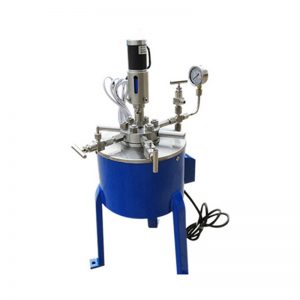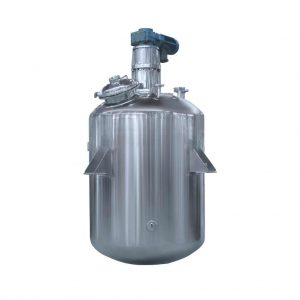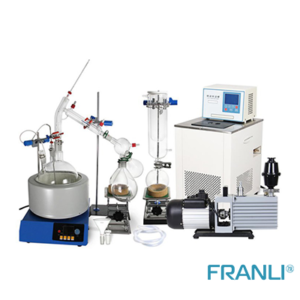Home » The best chemical reaction equipment – laboratory reactor
The best chemical reaction equipment – laboratory reactor
laboratory reactor
Details of Glass Reactor
- Using the latest reaction technology
- It has high temperature resistance, corrosion resistance, and high durability.
- Heating methods include steam, electric heater, high temperature heat transfer oil
- Using jacket, half pipe, fan coil, and other structures
Application: Chemicals, pharmaceuticals, dyes, pesticides, petroleum, food additives, etc.
The structure principle of laboratory reactor
1. The seal of the kettle body and the kettle cover adopts the triangular seal, which has a long service life.
2. The main seal uses a double-door snap ring, which freely touches the shoulders of the kettle body and the kettle cover, and evenly tightens the torque of the eight main sealing bolts, which can press the sealing kettle. When disassembling, loosen the 8 main bolts and open the snap ring to lift the lid, which is labor-saving and convenient, and is a modern domestic structure.
The kettle cover and the guide column are connected by the lifting arm, so that the lifting handwheel swings, and the kettle cover guides the column to move up, down, left, and right through the movement of the lifting thread, and the movement of the lifting arm works freely through the friction-reducing effect of the ball.
Rotation of the kettle cover and tilting of the kettle body for pouring and reset. First, use the lifting handwheel and lifting screw to lift the kettle cover to a certain height, loosen the twist of the fastening hand of the boom, and press and position the movable key kettle cover by hand, which can be rotated left and right. In addition, loosen the twist of the tightening hand of the rotating seat, press the rotating button to rotate the flip handle, ensure that the kettle body has a certain angle of material injection, and then release the rotating button to release the material. When it is necessary to reset the kettle body, shake the overturning handle and press the rotation button to quickly reset. In order not to swing the kettle body from side to side, it is necessary to control the speed until the overturn handle is reset by hand.
3. The rotary stirring adopts a cylindrical magnetic coupling structure, and the magnitude of the torque is determined by the magnetic material. Generally, ferromagnetic rare earth is used, which has a large coupling force. The motor is used as the power, and the stirrer generates sufficient stirring force through the coupler. The slurry can be replaced by the operator, and the components such as slurry, bolt, frame, and stirring worm gear are suitable for the viscosity of various substances.
4. The valve parts are equipped with a gas phase valve, liquid phase valve (also known as insertion pipe valve), safety burst valve, feed valve, and discharge valve, which can be increased or decreased according to user requirements. The structure adopts a reciprocating structure, and its characteristic is that the sealing life is 1.5 times longer than that of the rotary valve. The bursting valve is equipped with double safety devices and single-layer safety devices. The bursting diaphragm is adjusted in the factory and is not allowed to be adjusted or loosened arbitrarily. The pressure gauges are indicated directly above.
Laboratory reactor maintenance and maintenance
1. When using the laboratory reactor, the valve of the refrigerant inlet must be closed, and the remaining refrigerant in the pot and the casing to prevent illness must be put in, and then the material is imported;
2. Start the mixer, and turn on the steam valve and the electric heating power supply, after reaching the required temperature, close the steam valve and the electric heating power supply, and turn off the mixer after 2~3 minutes;
3. After processing, put the remaining condensed water in the pot and the casing, rinse with warm water as soon as possible, remove the material stained with the paste, rinse the inner wall of the container with 40~500c alkaline water, and rinse with water;
4. If it is an empty pot with no material (heat-absorbing medium) in the special pot, the steam valve, and electric heating power cannot be connected. Pay special attention to the use of steam pressure, which cannot exceed the rated working pressure.
5. To maintain the reaction kettle in the laboratory, always pay attention to the overall working conditions of the equipment and reducer. The reducer lubricating oil is insufficient and replenished in time, and the electric heating medium oil is replaced every six months;
6. Regularly check the safety valves, pressure gauges, thermometers, distillation holes, electric heating rods, electrical appliances, etc. Of the casing and pot cover, and replace or repair them in time if there is any fault;
7. When the laboratory reactor is not used, be sure to use warm water to thoroughly clean the inner and outer walls of the container, and scrub the body of the pot frequently to keep the outside clean and the inside bright to achieve the purpose of durability.
Precautions for the use of laboratory reactors
1. The laboratory reactor must be used in designated places,and the blasting outlet must be connected to the outdoor through pipelines during installation. When not in use for a long time, it is necessary to clean the inside and outside of the reactor and store it in a clean and non-corrosive dry environment.
2. Before the experiment, carefully check the test pressure, operating pressure, maximum operating temperature, and other performance parameters engraved on the reactor to ensure that the experiment is used under the conditions allowed by the reactor. Before placing the media, it is necessary to investigate whether the media is corrosive. If the experimental medium reacts violently, a large amount of gas is generated to reach ultra-high pressure and ultra-high temperature, or the medium contains chloride ions, fluoride ions, etc., special orders must be made as soon as possible.
3. After each experiment, the experimenter rotates the knob to the minimum position to ensure that each button is in the initial state every time the power is turned on, to avoid damage to the control equipment caused by the excessive current when the power is turned on.
4. Connect the corresponding voltage according to the operating voltage of the controller, single-phase 220v, three-phase 380v, so that the live wire and neutral wire of the controller are not opposite; to prevent electric shock, do not perform wiring work during power transmission! For normal work and the safety of the subjects, the ground wire must be connected! The controller itself is not explosion-proof, please avoid flammable and explosive environments! The pressure used by the pressure gauge is recommended to be used within 1/2 of the pressure shown. The pressure gauge of the reactor must be carefully compared with the standard pressure gauge for calibration.
5. When an abnormal sound occurs inside the isolation cover during the operation of the laboratory reactor equipment, stop immediately and release the pressure, and check whether the stirring system is abnormal. In addition, it is also necessary to regularly check the amount of oscillation of the stirring shaft. When the amount of swing is too much, please replace the bearing or sliding sleeve immediately.
6. The correct detection position of the speed display is very important for the stable display of the speed. This position of the laboratory reactor has been adjusted at the factory, please do not adjust it at will!
7. After the final reaction temperature is determined, the temperature setting value of the laboratory reactor must not be changed during heating, to avoid the temperature being too large and overshooting!
8. When the measuring instrument breaks, it usually breaks on the front and rear sides of its glass surface. Therefore, the experimenter should not stand in these hidden dangerous places when using the reactor.
9. When cleaning the autoclave, be careful not to let water and other liquids flow into the heating furnace, to prevent the heating furnace from breaking. When heating with heat-conducting oil, be careful not to add water and other liquids when adding heat-conducting oil, and check the oil level of heat-conducting oil from time to time.
10. When the laboratory reactor equipment is working or after the experiment, it is strictly forbidden to apply belt pressure for disassembly! The reactor is strictly prohibited to work under overpressure and overtemperature! Regularly check various instruments and blasting release devices to ensure accurate and reliable work.
Welcome to send inquiry to us and let’s make a win win business together !
Guidelines For Chemical Reactor
FRANLI has several complete chemical reactor production lines. Our chemical reactor adopts the latest infinitely variable speed reducer device, the sealing device can be a mechanical seal, and the heating and cooling can adopt the structure of a jacket, half pipe, fan coil, etc., The heating methods include steam, electric heater, and high-temperature heat transfer oil to achieve different safe processing environments such as acid resistance, heat resistance, wear resistance, and corrosion resistance.

Laboratory Reactor: Guide to Stirring System
The laboratory reactor is composed of a pot body, a pot cover, an agitator, a jacket, a support and transmission device, a shaft seal device, etc.

Overview of Laboratory Reactor
Laboratory reactors, also known as lab reactors, are essential tools in scientific research, product development, and process optimization. These reactors provide a controlled environment for conducting chemical reactions, mixing, dispersing, and homogenizing processes.

What is A Stainless Steel Reactor?
Stainless steel reactors are essential equipment in various industries, including chemical, pharmaceutical, biotechnology, and food processing.

Glass Reactor & Chemical Equipment
Glass reactors are essential equipment widely used in the chemical, pharmaceutical, and biotechnology industries. They come in various types, suitable for different applications.

Operating Guide for Laboratory Reactors
Laboratory reactors play a crucial role in chemical research and development. Understanding the proper operating procedures is essential to ensure accurate results and maintain a safe working environment.

Glass Reactors and Selection of Stirring Blades
Glass reactors, also referred to as glass reaction vessels, are vessels made from high-quality borosilicate glass material.

